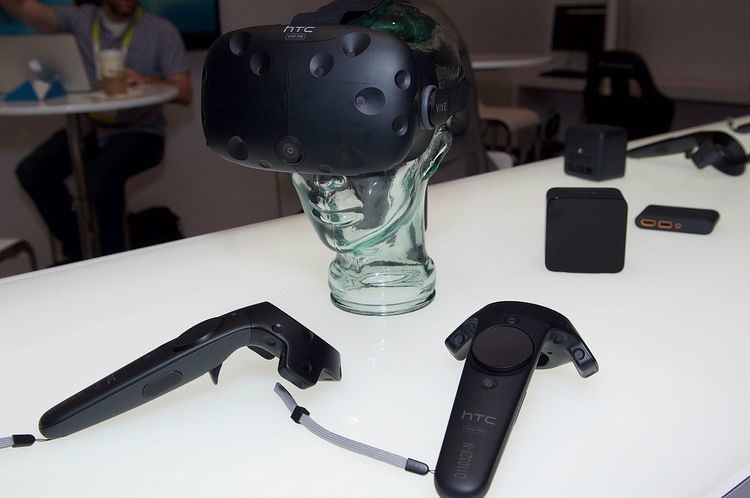Release date 5 April 2016 Refresh rate 90 Hz | ||
 | ||
Resolution 2160x1200 (1080x1200 per eye) | ||
HTC Vive is a high-end virtual reality headset developed by HTC and Valve Corporation, released on 5 April 2016. The headset is designed to utilize "room scale" technology to turn a room into 3D space via sensors, with the virtual world allowing the user to navigate naturally, with the ability to walk around and use motion tracked handheld controllers to vividly manipulate objects, interact with precision, communicate and experience immersive environments.
Contents
Unveiled during HTC's Mobile World Congress keynote in March 2015, the HTC Vive has since been awarded over 22 awards in CES 2016, including best of CES.
Development
Prototypes of a Valve-produced virtual reality system were demonstrated during 2014. On 23 February 2015, Valve announced that it would demonstrate a "SteamVR hardware system" at the 2015 Game Developers Conference. HTC officially unveiled its device, Vive, during its Mobile World Congress keynote on 1 March 2015. Preorders started on 29 February 2016 at 10:00 a.m. EST. Valve and HTC have since announced that the headset will be free for selected developers.
At Consumer Electronics Show 2016, HTC and Valve unveiled a near-final hardware revision of the device, known as HTC Vive Pre.
SteamVR will offer native support for Unity on its platform.
Gabe Newell has confirmed a new version of the Vive- codenamed VIVE 2- OASIS is currently in early development. VIVE 2 will feature smaller more efficient lighthouses, new controllers, specialized display technology and a smaller and lighter wireless headset.
History
During his Immersed 2015 keynote, Phil Chen, Chief Content Officer for HTC and Founder of the HTC Vive explained that he "stumbled upon VR" and later HTC met Valve, which turned out to be "serendipity". Chen also explained that HTC and Valve don't have a clear dividing line between each of their responsibilities, and HTC is very much a partner in the research and development process.
In November 2016, HTC announced a tether-less VR upgrade kit made by TPCAST. A public model was shown at CES 2017 and had a price of $249.
Technical specifications
The Vive has a refresh rate of 90 Hz. The device uses two screens, one per eye, each having a display resolution of 1080x1200. The device uses more than 70 sensors including a MEMS (Microelectromechanical systems) gyroscope, accelerometer and laser position sensors, and is said to operate in a 15-by-15-foot (4.6 by 4.6 m) tracking space if used with both "Lighthouse" base stations that track the user's movement with sub-millimeter precision. The Lighthouse system was designed by Alan Yates and uses simple photosensors on any object that needs to be captured; to avoid occlusion problems this is combined with two lighthouse stations that sweep structured light lasers within a space.
The front-facing camera allows the software to identify any moving or static objects in a room; this functionality can be used as part of a "Chaperone" safety system, which will automatically display a feed from the camera to the user to safely guide users from obstacles.
Games
By March 2016, the time at which the pre-orders for the HTC Vive opened, 107 games were known to be coming to the virtual reality format.
In February, 2017 VALVE Ceo Gabe Newell announced via Reddit AMA 'ask me anything' session VALVE is developing three AAA VIVE IPs alongside the forthcoming 'Knuckles' controllers.
An open source program called Revive allows for Oculus Rift games to be used with an HTC Vive. Although it has been patched out before, it came with a large public backlash that forced Facebook to revert the decision.
Adoption
Valve places a strong emphasis on the independent developer as well as user developed content demonstrable through Valve's Steam Workshop platform, a feature of Steam (Valve's gaming ecosystem featuring hundreds of millions of active users). HTC Vive has an open policy with independent developers, stating they should "go and be healthy", contributing to the VR community as a whole. The versatility of the Vive's both seated and proprietary room scale virtual reality facilitates expansive potential for diverse applications that extend beyond gaming. These include practical applications for healthcare, education, social change, communications, the arts, design, architecture, humanitarianism and space applications employed by NASA and many more. Valve released its OpenVR software development kit (SDK), an updated version of its Steamworks VR API with documentation and examples of how to build software that supports SteamVR hardware in April 2016. It provides support for the HTC Vive Developer Edition, including the SteamVR controller and Lighthouse.
On 30 April 2015, Epic Games announced support for Valve's SteamVR technology, allowing developers to create VR projects with Unreal Engine 4 for the HTC Vive. Epic said that SteamVR is completely integrated into Unreal Engine 4 across Blueprint visual scripting and native code, meaning projects can be built without being dependent on programmer support if needed. Epic's own Showdown tech demo can already be experienced on SteamVR using the Vive headset. jMonkeyEngine, a free cross-platform 3D engine, is also getting support for OpenVR and the Vive. Elite: Dangerous, a space exploration and trading game, added Vive support in April 2016.
In July 2016, VR news website Road to VR used game session figures from the Steam VR platform to estimate that approximately 100,000 Vive headsets had been shipped since launch. In the same month, SensoMotoric Instruments (SMI), a computer vision company, integrated its eye tracking technology in the HTC Vive to turn it into a dedicated eye tracking solution for research and professional applications. In November 2016, Vive announced that it would begin the first retail sales of its headsets at JB Hi-Fi and Harvey Norman stores in Australia later that month.
On 23 November 2016, HTC announced that the Vive was sold at a profit and that HTC Vive sales were "much higher" than 140,000.
